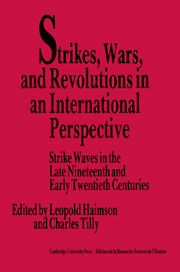 Strikes, Wars, and Revolutions in an International Perspective
Strikes, Wars, and Revolutions in an International Perspective Book contents
- Frontmatter
- Contents
- List of contributors
- Preface
- Part I Introductions
- Part II Models and realities
- 3 Introduction
- 4 Changing forms of labor conflict: secular development or strike waves?
- 5 Strikes and power in Britain, 1870–1920
- 6 Two strike waves in Imperial Russia, 1905–1907, 1912–1914
- 7 Strikers in revolution: Russia, 1917
- 8 Strikes in Imperial Russia, 1895–1913: a quantitative analysis
- 9 Labor conflicts in Italy before the rise of fascism, 1881–1923: a quantitative analysis
- 10 Strikes and politics in the United States, 1900–1919
- Part III Workers in metal-processing enterprises in comparative perspective
- Part IV The effects of short-term variation
- Part V Conclusion
9 - Labor conflicts in Italy before the rise of fascism, 1881–1923: a quantitative analysis
Published online by Cambridge University Press: 25 March 2010
- Frontmatter
- Contents
- List of contributors
- Preface
- Part I Introductions
- Part II Models and realities
- 3 Introduction
- 4 Changing forms of labor conflict: secular development or strike waves?
- 5 Strikes and power in Britain, 1870–1920
- 6 Two strike waves in Imperial Russia, 1905–1907, 1912–1914
- 7 Strikers in revolution: Russia, 1917
- 8 Strikes in Imperial Russia, 1895–1913: a quantitative analysis
- 9 Labor conflicts in Italy before the rise of fascism, 1881–1923: a quantitative analysis
- 10 Strikes and politics in the United States, 1900–1919
- Part III Workers in metal-processing enterprises in comparative perspective
- Part IV The effects of short-term variation
- Part V Conclusion
Summary
Introduction
The aim of this paper is to provide a synthetic, quantitative analysis of labor conflicts in Italy as they are recorded in official strike statistics from the last decades of the nineteenth century to the ascent of fascism. The qualification, “as they are recorded by the official statistics on strikes,” imposes two limits. First, forms of industrial unrest other than strikes, such as boycotts, restriction of output, and absenteeism and sabotage, will not be considered here. If it is true that these various types of conflict are to some extent interchangeable (Knowles 1952, 285), and that restricting one specific manifestation might “merely divert the conflict to other forms” (Hyman 1972, 55), this limitation will be particularly significant in the Italian context, where especially during the first decades analyzed here, the legal and political environment was rather hostile both to unionization and to industrial strikes.
Second, the official statistics provided by the government record only “economic” strikes, that is, “those which aim to obtain better working conditions directly from the employer.” Excluded are “political” strikes and those aiming to obtain the passage of some specific legislation or to achieve economic improvements through government measures. It could be, as one Italian scholar put it (Foa, 1975, 1799), that in Italy even more than in other countries the strike movement captured only a portion of labor activity, and that the social strains of the period are better expressed by indices such as migration, crime, and massacres.
- Type
- Chapter
- Information
- Strikes, Wars, and Revolutions in an International PerspectiveStrike Waves in the Late Nineteenth and Early Twentieth Centuries, pp. 217 - 246Publisher: Cambridge University PressPrint publication year: 1989
- 2
- Cited by


